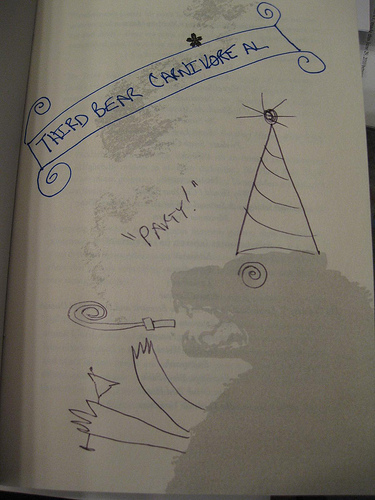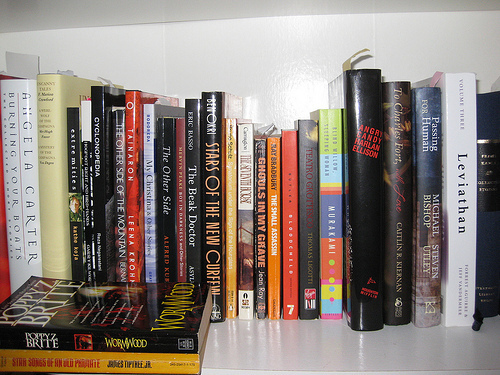Jeff VanderMeer's Blog, page 91
July 14, 2010
Launch Pad, Day Three: Kevin R. Grazier on Space Environment
To see more of my posts on Launch Pad, click here.
Note: The schedule had Kevin's lecture today swapped with his lecture yesterday. Today is really space environment. Yesterday was actually gravity, newton, kepler, orbits.
Mass in space:
There is no mas sin space, outside of planets and stars, etcetera. That's why it's called space.
Though strictly speaking, that's not true; there are about 16 atoms per cubic inch, on average. This is much less than in the vacuums we create in laboratories.
The s...
Launch Pad, Day Three: Mike Brotherton on Everything You Wanted to Know About Stars…
To see the rest of my launch pad posts, click here.
Stars are the bread and butter of astronomers. They're the building blocks of galaxies. They're well-understood in the basics these days. You can go into the details, starting with the understanding that they're burning balls of glass, and we move from there to a detailed understanding of their chemical structure, lifespans, how they're born, how they die. There are some areas that are still active areas of research, but I'm going to go into ...
Get Your Squid on, Weirdies (And Throw Some Shark on There, Too)
Yes, that's right, you can win Mieville's Kraken and my The Third Bear, and all you have to do is what every good upstanding weirdie wants to do anyway: write about squid, octopi, or cuttlefish.
Want some shark with that ceph?

Launch Pad Day Two Catchup-Post, Spectroscopy and Goggles on the Roof
Yesterday, we did two activities that were not conducive to laptop-taking and note-producing. One was a lab with Jim Verley on spectroscopy in which he gave us spectroscopes and had us look at argon, helium, hydrogen, and a few other elements, so that we could see how they broke down into color spectrums. Some were easier to see than others–neon, for instance, looked like a rainbow. Argon was very hard to see; the element itself glowed purple, but the vague hint of a purple line it sent out w...
July 13, 2010
Launch Pad, Day Two: Kevin R. Grazier on Space Environment
To see the rest of my posts about Launch Pad, click here.
If there's one thing you learn in astronomy that's fundamental, it's energy. We're going to learn about energy and about orbits which are dependent on the energy of what they're orbiting. When we talk about the science in science fiction, we'll hearken back to this because energy explains a lot.
An example: on BSG we used bullets in our vipers instead of lasers. People thought it was low tech, but it's harder to get a lot of energy in ...
Launch Pad, Day Two: Mike Brotherton on the Electromagnetic Spectrum, Light, Instruments, Telescopes
To see the rest of these Launch Pad posts, click here.
Ian Randal Strock was curious about how far away we'd have to be from the sun before it started to appear to be a point rather than a disk. To answer the question, first we have to look at how humans see distant objects: The angular size of an object is proportional to its physical size divided by its distance from us. So if you double the size of an object, it's going to cover an angle twice the size. If you move the object twice as far a...
Third Bear Carnival: Sensio Sees You

Well, that's awfully nice, and very flattering, even if most of the entries wind up being "WTF? What is *wrong* with him?!" Matt Cheney has organized a Third Bear Carnival around my new short story collection (which appears to be out this week, a little early), and also contributed the first entry, about my story "The Quickening."
"The Quickening" is a new story, and features a white rabbit named Sensio in 1950s Central Florida. Sensio may be a talking rabbit. It's never quite clear, is it...
Launch Pad, Day Two: Origins of the Moon
To check out all the Launch Pad posts so far, visit this link.
In response to a question from Ian Randal Strock, Mike Brotherton sent us this youtube video on the Origins of the Moon:
Click here to view the embedded video.
Last night, when Kevin R. Grazier's lecture on the solar system and the cassini probe lasted three hours, an extra hour more than scheduled, Carrie Vaughn noted, "Back when I was in second grade, in the astronomy text book I loved so much, that whole lecture could only have...
July 12, 2010
The Weird: Comparisons

Ann and I are not quite ready to announce the table of contents for The Weird: A Compendium of Strange and Dark Fictions, but it is interesting to compare our almost-final list of stories to two anthologies with a similar scope and overlapping focus.
Just to recap, we're covering 100 years of weird/the weird, starting in 1908 with an excerpt from Alfred Kubin's The Other Side, Algernon Blackwood's "The Willows", and F. Marion Crawford's "The Screaming Skull." In addition to wanting to cover a ...
Launch Pad, Day One: Kevin R. Grazier on Solar System/Cassini
How many solar systems are there in the galaxy? One. One star is called sol. There is one solar system. It is a proper noun and should be capitalized. Solar System.
It starts with an exploding star. Stars of very large size live by the credo "live fast, die young, live a good-looking black hole." A supernova can outshine the sum total of all other stars in its galaxy.
Fusion–fundamental energy creation process in our sun, a proton-proton chain. You slam hydrogen together, make helium and...



